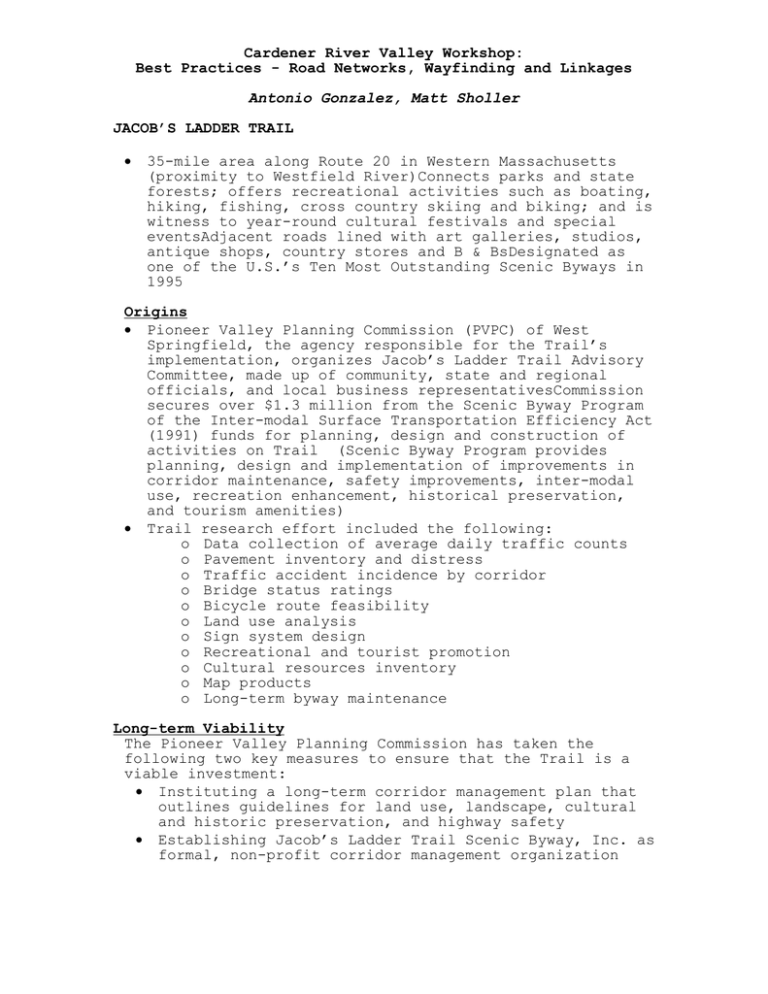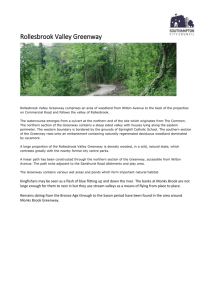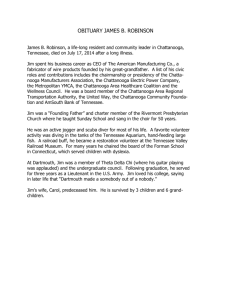Document 13640204
advertisement

Cardener River Valley Workshop: Best Practices - Road Networks, Wayfinding and Linkages Antonio Gonzalez, Matt Sholler JACOB’S LADDER TRAIL • 35-mile area along Route 20 in Western Massachusetts (proximity to Westfield River)Connects parks and state forests; offers recreational activities such as boating, hiking, fishing, cross country skiing and biking; and is witness to year-round cultural festivals and special eventsAdjacent roads lined with art galleries, studios, antique shops, country stores and B & BsDesignated as one of the U.S.’s Ten Most Outstanding Scenic Byways in 1995 Origins • Pioneer Valley Planning Commission (PVPC) of West Springfield, the agency responsible for the Trail’s implementation, organizes Jacob’s Ladder Trail Advisory Committee, made up of community, state and regional officials, and local business representativesCommission secures over $1.3 million from the Scenic Byway Program of the Inter-modal Surface Transportation Efficiency Act (1991) funds for planning, design and construction of activities on Trail (Scenic Byway Program provides planning, design and implementation of improvements in corridor maintenance, safety improvements, inter-modal use, recreation enhancement, historical preservation, and tourism amenities) • Trail research effort included the following: o Data collection of average daily traffic counts o Pavement inventory and distress o Traffic accident incidence by corridor o Bridge status ratings o Bicycle route feasibility o Land use analysis o Sign system design o Recreational and tourist promotion o Cultural resources inventory o Map products o Long-term byway maintenance Long-term Viability The Pioneer Valley Planning Commission has taken the following two key measures to ensure that the Trail is a viable investment: • Instituting a long-term corridor management plan that outlines guidelines for land use, landscape, cultural and historic preservation, and highway safety • Establishing Jacob’s Ladder Trail Scenic Byway, Inc. as formal, non-profit corridor management organization Cardener River Valley Workshop: Best Practices - Road Networks, Wayfinding and Linkages Antonio Gonzalez, Matt Sholler CHATTANOOGA, TENNESSEE The Tennessee River Greenway and Riverwalk was a result of an intensive planning process in 1984 with a strong emphasis on citizen participation. Over 1700 townspeople participated in a 4- month long process headed by Chattanooga Venture, a non-profit organization focused on environmental, economic, and social improvement. This citizen task force called for a greenway path linked with housing, parks, businesses, and tourist attractions throughout metropolitan Chattanooga. The Greenways can also serve as walkways and bicycle commuting routes, thus increasing recreation and reducing automobile pollution. The Greenway Park is comprised of 200 hectares of green space along the Tennessee River with a Greenway Farm. The Greenway Farm doubles as a conference center and a clearinghouse for information on outdoor activities in the Tennessee Valley. Currently, there are six greenways nearing completion with plans for an additional 75-100 miles. Valuable Lessons • Result of broad-based planning process • Emphasis on environmental clean up raises community awareness about environment -- Spillover effects include electric city buses and demand for alternative energy vehicles Greenway Farm in park doubles as conference center and a clearinghouse for information on outdoor activities in Tennessee Valley IMPORTANT LINKS / INFO Design Center http://www.chcrpa.org/design%20center.html -- a development partnership managed by the RPA. It focuses on downtown planning and historic preservation, offering assistance to both public and private projects. It also oversees development in areas where legislation requires design review and approval, including the riverwalk, the 20-block downtown Cardener River Valley Workshop: Best Practices - Road Networks, Wayfinding and Linkages Antonio Gonzalez, Matt Sholler overlay zone, and the north shore commercial district. 850 Market Street (upstairs) 266-5948 Chattanooga Environmental Education Alliance coalition to raise environmental awareness in community, formed in 1992. http://www.chattanooga.net/environet/members.html Chattanooga Chamber of Commerce http://www.chattanooga.gov/cpr/Recreate2008/ The Greenway Advisory Board, under the Mayor’s office, meets at least four times a year to develop recommendations for the Chattanooga Greenway System including planning, routing, protection, design, leases, exchanges, operation and programs. 265-5229 or 757-5169 Best Practice : Greenways, short article on Chatt. http://www.bmpcoe.org/bestpractices/external/chatt/chatt_4.h tml Oregon Statewide Planning Program http://www.lcd.state.or.us/


